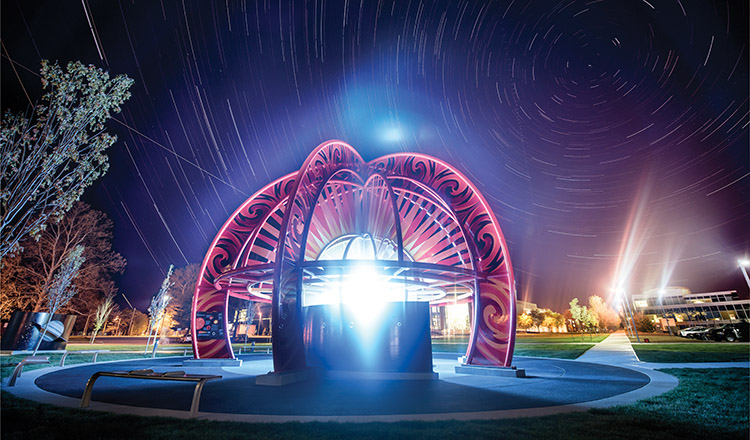At age 10, Janice Voss (AAE’75) read A Wrinkle in Time by Madeleine L’Engle, a children’s book about space, time travel, and the gravitational pull of family. Immediately, Janice’s universe exploded. Within the pages of that classic science fiction book, Janice pinpointed her star, her endless fresh life — she wanted to be an astronaut.
Visiting Our Solar System — VOSS — is a bold interactive walk-through sculpture of the planetary system designed by a team of Purdue students in Engineering Projects in Community Service — EPICS. The 45-foot-diameter metal auburn and gold sun and its orbiting planets of marble set in six-foot-high walls beckon visitors as a crowning jewel of Discovery Park. The solar system plaza honors the late Purdue engineering alumna and NASA astronaut Janice Voss.
Janice was the first woman astronaut to graduate from Purdue. She relished interacting with students about her passion for science, math, space, and Purdue. Dedicated in April, the VOSS sculpture inspires children and adults to explore, touch, read, and learn about the solar system.
“It sure makes a statement,” says Louise Voss (HHS’50), Janice’s mother. “I think Janice would be pleased. It’s in line with the kind of attitude she always had. She enjoyed nature, the earth, what’s outside the earth, and where we might be going. It all fits.”
At age 16 as a freshman at Purdue, Voss began work with NASA in the Johnson Space Center’s co-op program. She became an astronaut in 1991 and served on five space shuttle missions, including the only repeat flight in the shuttle program’s 30-year history. She flew with the first commercial laboratory, rendezvoused with Russia’s Mir space station, and helped create the most complete digital topographic map of the Earth. Voss explored the behavior of fire in weightlessness, how plants adapt to extraterrestrial flight, and other phenomena while logging nearly 19 million miles circling the Earth. She passed away from breast cancer in 2012 at age 55, having lived her own version of A Wrinkle in Time.
A book, too, can be a star, explosive material, capable of stirring up fresh life endlessly, a living fire to lighten the darkness, leading out into the expanding universe.
—Madeleine L’Engle, author, A Wrinkle in Time
The idea of a solar system model began in 2009 through the impetus of then First Gentleman Chris Foster, Purdue’s K-12 STEM coordinator, and the support of Purdue President France A. Córdova. Carrying forth the idea, Professor Barrett Caldwell, director of the Indiana Space Grant Consortium, challenged EPICS students to develop a planetary replica that would inspire STEM disciplines.
“EPICS students work in teams on projects that impact a community,” says William Oakes, director of EPICS. “In this case, the community was Purdue.”
VOSS began solely as a tabletop model, but during 13 semesters, students expanded the project into a towering fresh-air tribute that is now a Purdue landmark.
Students led a national design competition garnering a couple thousand submissions. A jury selected Indianapolis artist Jeff Laramore, who teamed with Smock Fansler Construction to transform the students’ preliminary design into reality.
At first, a linear solar system model was proposed. “Most models put the planets in line, like the one on the National Mall in Washington, DC,” says Oakes.
But linear has its challenges. The planets would have snaked through campus. “If you put the sun at Discovery Park, Neptune would be somewhere near Ross-Ade Stadium,” says Caldwell. “And what would you do if you found out that the orbit of Jupiter would be in the middle of State Street? That would get awkward.”
VOSS became a Fibonacci spiral design, a shape found in the natural world in sunflowers, pinecones, nautilus shells, Hurricane Katrina, and, of course, the solar system. “Students came up with something that is much more interesting, interactive, and educationally sound than what we had envisioned,” says Oakes.
The idea of A Wrinkle in Time is that the fabric of space/time “wrinkles” or folds onto itself, creating new paths for travel that are quicker than the straight line between two points. In essence, EPICS students designed VOSS echoing the “wrinkle” concept, not knowing of the favorite girlhood book of Janice Voss.
In a 2007 interview, Voss explained why she loved A Wrinkle in Time, “What appealed to me was the sense that you just figure out what you need to do to solve the problem, and you use all the resources and you pull all these interesting technologies together, whatever you can find, to solve the problem with the help of your family and friends.”
Visiting Our Solar System is a glowing homage to the ingenuity of Purdue students, Voss’s vision to teach youngsters the fun of math and science, the power of the written word to influence a life, and the childhood wonder of space and time.

